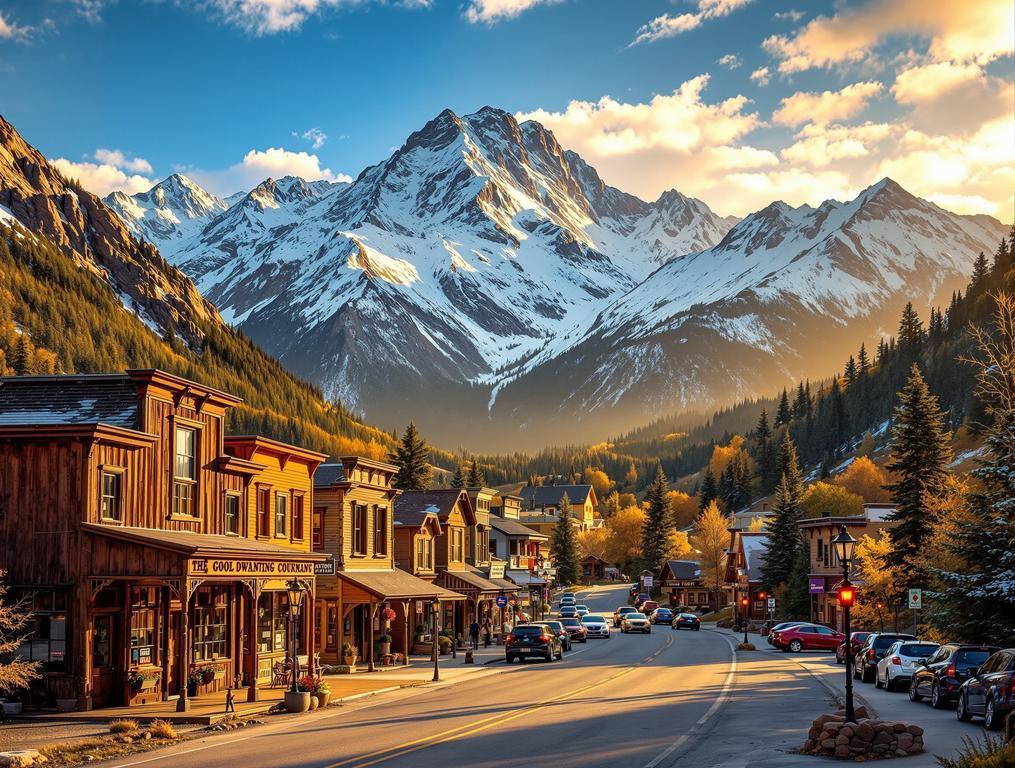The narrow gauge train chugs into view as I step onto Silverton’s Greene Street at 9,318 feet elevation. My lungs feel the altitude immediately. Below me, just 768 residents maintain this perfectly preserved slice of Wild West history, tucked high in Colorado’s San Juan Mountains. I’ve explored mining towns across America, but something feels different here – as if I’ve discovered the Swiss Alps hiding in the American Rockies.
Beyond the Victorian storefronts, snow-capped peaks stretch in every direction. Sarah captures photos while my daughter Emma points to the historic Durango & Silverton Narrow Gauge Railroad that just delivered us after a 45-mile scenic journey through stunning mountain passes.
“This feels nothing like those crowded resort towns,” she whispers, already sensing what makes this place special.
America’s highest historic town sits 9,318 feet above sea level
Silverton isn’t just another mountain town – it’s America’s highest historic mining settlement with a population over 500. This tiny 0.8-square-mile community packs more authentic Western heritage into its grid of streets than towns ten times its size.
Walking past the Grand Imperial Hotel, I notice how the thin mountain air carries sounds differently. The creak of wooden boardwalks and distant echo of the departing train create an atmosphere that’s half Colorado, half time machine.
The town’s isolation – 52 miles north of Durango via the Million Dollar Highway – has preserved what many other destinations lost to development. Rather than being buried under condo complexes, Silverton’s National Historic Landmark District status protects its collection of brick and wooden buildings dating to the 1880s silver boom.
My local guide explains that while the mines closed decades ago, Silverton reinvented itself without sacrificing authenticity. Summer brings hikers, history buffs, and travelers seeking experiences beyond Colorado’s better-known destinations.
Where the Wild West meets European Alps in a preserved Victorian setting
As I climb Blair Street, Silverton’s infamous former red-light district, the afternoon light casts long shadows across weathered facades. The 9,318-foot elevation creates a quality of light photographers chase for hours – what Sarah calls “alpine gold.”
Like Nevada’s “American Alps” experience near Elko, Silverton offers European mountain beauty without crossing the Atlantic. But here, the Victorian architecture creates a uniquely American contrast – rugged mining heritage meets Alpine splendor.
“I’ve been to Zermatt in Switzerland, and this feels similar but with an authentic American story. You get that high-mountain experience but with cowboys instead of chalets.”
Victorian architectural preservation enthusiasts might note similarities between Silverton’s well-maintained buildings and Washington’s Port Townsend historic district. Both towns preserve their architectural heritage, but Silverton does so at nearly twice the elevation.
At the San Juan County Historical Society Museum (housed in the old county jail), displays tell stories of mining disasters and resilience. Western mining towns like Silverton and Montana’s Anaconda preserve America’s industrial heritage through architectural landmarks.
From mining disasters to tourism triumph: Silverton’s remarkable resilience
The devastating avalanches of 1906 nearly wiped Silverton off the map. Yet today, this resilient community welcomes visitors seeking both history and adventure without the pretension of Colorado’s resort towns.
For outdoor enthusiasts, the surrounding mountains offer world-class hiking. The challenging Ice Lakes Trail rewards with electric-blue alpine lakes, while the Alpine Loop provides 4×4 adventures through ghost towns and mountain passes.
What makes Silverton special isn’t just what it offers, but what it lacks – no traffic jams, no chain restaurants, no manufactured experiences. Like Idaho’s Sun Valley, Silverton has mastered balancing tourism with authenticity.
How to experience Silverton: Practical travel tips for summer 2025
Visit between June and September when mountain passes are reliably open. July offers perfect weather, with daytime temperatures in the comfortable 70s and cool evenings requiring a light jacket.
While exploring Silverton’s hiking trails, consider timing your visit with Colorado’s spectacular July wildflower season for an enhanced alpine experience.
The Durango & Silverton Narrow Gauge Railroad runs daily through October, with the first train arriving at noon and departing at 2:30 PM. Book at least two weeks ahead during peak summer months.
For accommodations, choose between historic hotels like the Grand Imperial (from $159/night) or the more intimate Teller House ($129/night). Both offer walking access to everything in town.
As Emma and I walk back toward the train station, she collects pebbles for her rock collection while I reflect on what makes places like Silverton essential to understanding America. In our rush toward the future, we sometimes forget to preserve authentic pieces of our past.
Here at 9,318 feet, Silverton reminds us that the most meaningful travel experiences often come in small packages – especially when they’re wrapped in mountain vistas and mining history, waiting to be discovered by those willing to venture beyond the familiar.
